 Toyota Camry XV30 (2002–2006) Service ManualTheft deterrent & door lock
Toyota Camry XV30 (2002–2006) Service ManualTheft deterrent & door lock
Theft deterrent system
Theft deterrent system
ON−VEHICLE INSPECTION
1. OUTLINE OF THEFT DETERRENT SYSTEM
-
When the theft deterrent system detects that the vehicle is being tampered with, the system sets off the alarm, causing the horns to sound and the lights to light up or blink in order to alert people around the vehicle to the theft.
-
The theft deterrent system has 2 modes; one is active arming mode and the other is passive arming mode. Passive arming mode can be switched ON/OFF by the specified method (See step 6).
-
Each mode has 4 states; disarmed state, arming preparation state, armed state, alarm sounding state.
1. Disarmed state:
-
The alarm function is not operating.
-
The theft deterrent system is not operating.
2. Arming preparation state:
-
The time until the system goes into the armed state.
-
The theft deterrent system is not operating.
3. Armed state:
-
The theft deterrent system is operating.
HINT: If the vehicle remains in a condition that sets off the alarm (any door remains open, engine hood remains open, luggage compartment door remains open, ignition switch remains directly connected) after the alarm ends, the alarm will be set off repeatedly a maximum of 10 times for every one of the above specified conditions.
Alarm time: (60 sec. ± 5 sec.) x 10
4. Alarm sounding state: When the theft deterrent system detects that the vehicle is being tampered with while in the armed state, the system causes the horns to sound and the lights to light up or blink in order to alert people around the vehicle to the theft.
Refer to the table below for the alarm method and time:
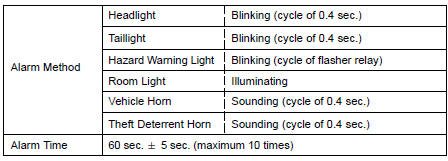
HINT: If either of the doors is unlocked and there is also no key in the ignition key cylinder during the armed state, a forced door lock signal will be output (See step 4).
2. ACTIVE ARMING MODE
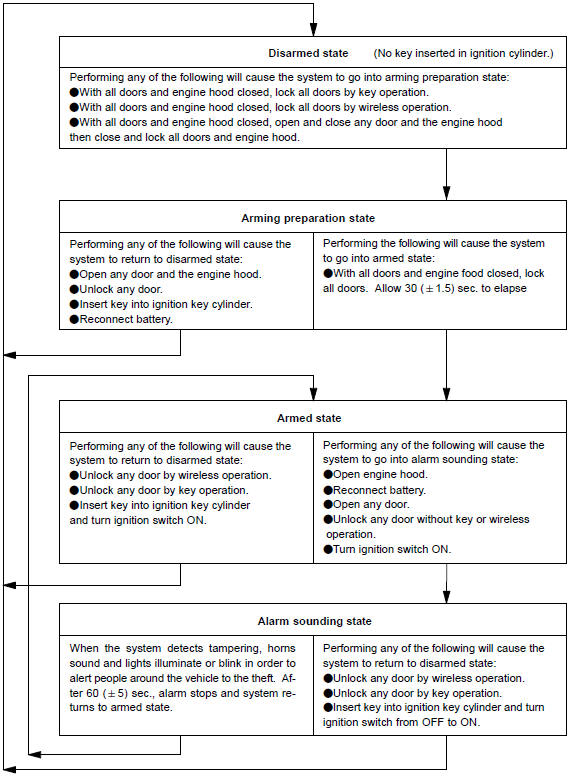
3. PASSIVE ARMING MODE
-
Passive arming mode can be switched ON/OFF by the specified method (See step 6).
-
The mode set initially (shipped from factory) is active arming mode (not passive arming mode).
-
During passive arming mode, the theft deterrent system goes into the armed state even if the doors are not locked.
-
Passive arming mode starts the alarm control after the key is removed from the ignition key cylinder and the doors are closed.
-
Detecting that the doors are unlocked does not set off the alarm during passive arming mode.
-
A forced door lock signal is not output during passive arming mode (See step 4).
-
When the theft deterrent system detects that the doors are opened during passive arming mode, the alarm is not set off immediately because an entry delay time is set.
-
If either of the following conditions is fulfilled during passive arming mode, the theft deterrent system will switch to active arming mode.
-
With all doors and engine hood closed, lock all doors by key operation.
-
With all doors and engine hood closed, lock all doors by wireless operation.
-
With all doors and engine hood closed, open and close any door and the engine hood then close and lock all doors and engine hood.
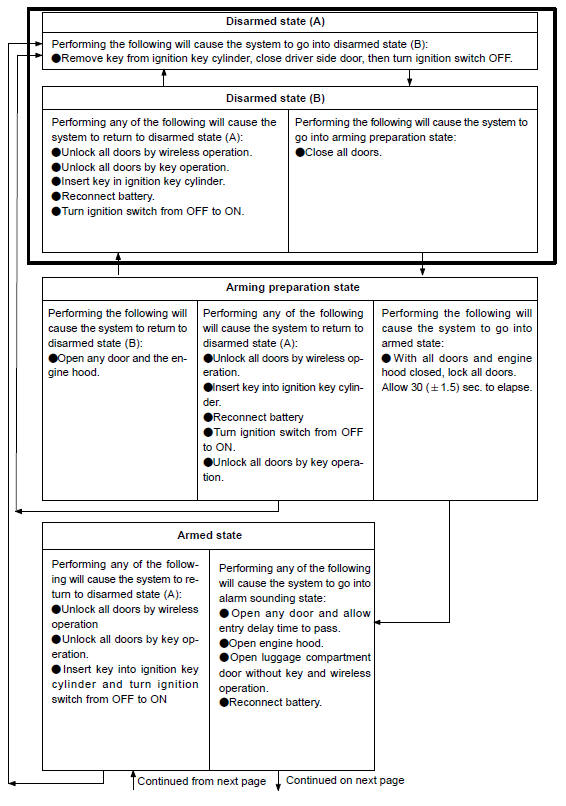
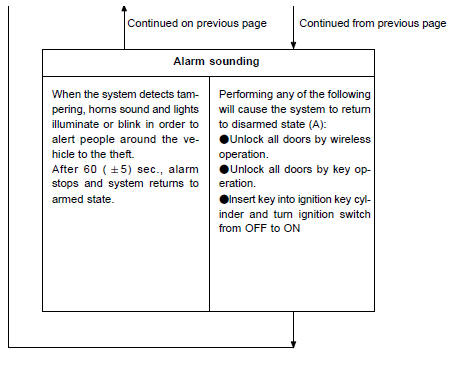
*3: When any door is opened while all the doors are closed during the armed state in passive arming mode, the entry delay time starts. If the switch condition (armed state " disarmed state) is fulfilled during the entry delay time, the theft deterrent system will return to the disarmed state. However, if the switch condition to the disarmed state is not fulfilled, the theft deterrent system will recognize it as a theft and go into alarm sounding state.
Entry delay time of 0, 14 or 30 sec. can be selected by the customizing function.
4. FORCED DOOR LOCK CONTROL
a. The forced door lock control prevents the vehicle from being tampered with. Immediately after a door is unlocked (alarm starts), the door is forced to lock by a forced door lock signal.
1. Conditions that force the doors to lock: When no key is in the ignition key cylinder and 0.4 second has elapsed after the previous output of a forced door lock signal, the doors will be forced to lock if any of the following conditions is fulfilled.
-
The theft deterrent system is in the armed state of active arming mode.
-
All the doors are locked. → Any door is unlocked.
-
Any door is unlocked state.
5. SECURITY INDICATOR LIGHT OUTPUT
a. The theft deterrent ECU outputs a signal to light up the security indicator light, according to the state of the theft deterrent system. However, some of the actual lighting conditions of the security indicator light are different from the outputs of the theft deterrent ECU.
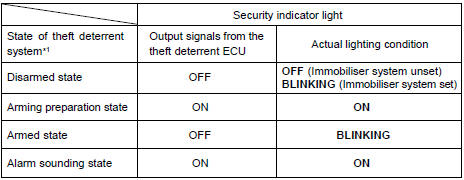
*1: Common to active arming mode and passive arming mode
Blinking cycle:

HINT: When the immobiliser system is set, the security indicator light blinks during the disarmed state and the armed state, due to the output signals from the immobiliser system.
6. CHANGING METHOD OF PASSIVE MODE (ON or OFF)
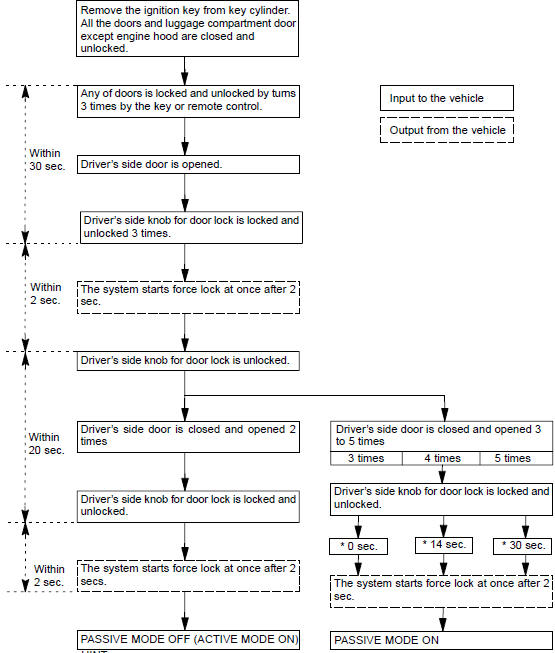
HINT:
-
Initial mode is PASSIVE MODE OFF.
-
If the ignition switch is turned ON, changing operation will be canceled.
*: Entry delay time
Power door lock control system
Key unlock warning system
Engine immobiliser system (2AZ−FE(PZEV))
Engine immobilizer system (Except 2AZ−FE(PZEV))
Theft deterrent system
Power door lock control system
Wireless door lock control system
Door control transmitter
Toyota Camry XV30 (2002–2006) Service Manual
- Introduction
- Audio & visual system
- Automatic transmission / trans
- Brake
- Clutch
- Communication system
- Cooling
- Cruise control
- Drive shaft / propeller shaft
- Emission control
- Engine control system
- Engine hood/door
- Engine mechanical
- Exhaust
- Exterior/interior trim
- Front suspension
- Fuel
- Heater & air conditioner
- Ignition
- Instrument panel/meter
- Intake
- Lighting
- Lubrication
- Manual transmission/transaxle
- Parking brake
- Power steering
- Rear suspension
- Seat
- Service specifications
- Sliding roof/convertible
- Starting & charging
- Steering column
- Supplemental restraint system
- Theft deterrent & door lock
- Tire & wheel
- Windshield/windowglass/mirror
- Wiper & washer
- Wiring
